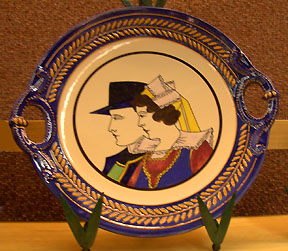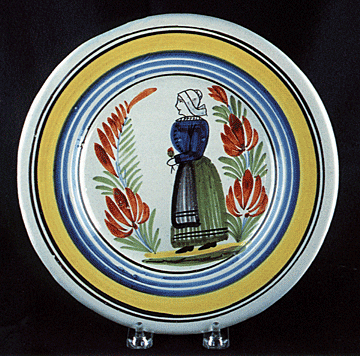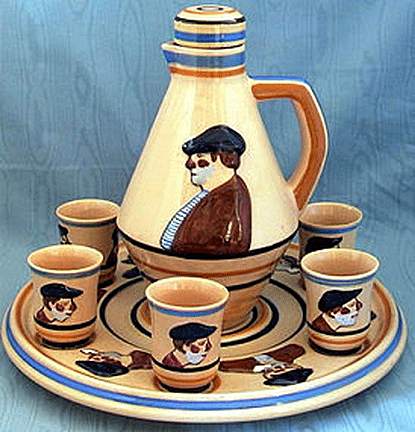|
 Quimper, France, a charming Breton town just six
hours from Paris, is steeped in tradition. Its pottery, also known by the
same name, is likewise. Quimper, France, a charming Breton town just six
hours from Paris, is steeped in tradition. Its pottery, also known by the
same name, is likewise.
"I'd like to dispel a number of myths about Quimper,"
said Joan Datesman, one of the top three dealers in Quimper in the U.S.
"The first one is that Quimper is a charming little village; it's a
major city of the region. The second is that this pottery used to be made by
the orphan children in France. And the third is that Renoir worked there
when he was young."
The first ceramics made in France were known as faience,
or pottery in French. The word faience became part of the French
language after the introduction of the popular white wares from Faenza,
Italy, in the late sixteenth and early seventeenth centuries. This type of
pottery lends itself well to the unique designs that come from Quimper. In
fact, many of the old techniques are still in use today.
What is Quimper?
Quimper pottery consists of a clay base--usually of red
clay--either formed by hand or molded by the artful hands of the potter. Its
rather thick beige or pinkish clay bisque form is then given a tin glaze
composed of fine sand (silica), tin oxides, and lead, and an alkali, such as
marine salt, potash or soda. Due to the infinitesimal particles of tin
oxide, the glaze remains white and opaque. It's ideal for decoration as well
as to close the pores of the clay pieces to allow for functional use.
 Since tin glazes don't run when fired, the decoration can
be painted directly on the pottery without danger of being absorbed into the
clay and smudged. The French artisans learned the "potter's
secret" of tin glaze from Italian and Spanish artists employed by the
papal court in Avignon in the fourteenth century, at which time floor tiles
were being made in green, purple and yellow. Since tin glazes don't run when fired, the decoration can
be painted directly on the pottery without danger of being absorbed into the
clay and smudged. The French artisans learned the "potter's
secret" of tin glaze from Italian and Spanish artists employed by the
papal court in Avignon in the fourteenth century, at which time floor tiles
were being made in green, purple and yellow.
Around 1500, Italian potters introduced the Italian
technique of pottery making into Northern Europe. Some migrated to France
around 1530 and established a factory at Rouen to make floor tiles for
churches and chateaux. By 1545 this factory was making apothecary jars in
the Italian style.
In time the Rouen district became a leading center of
faience production and remained so throughout the 17th and 18th century.
Early pieces were primitive, with wobbles in the plates, less than
symmetrical teacups, and large platters with a decided tilt to them.
Technique
 All early French faience was fired at a high
temperature known as grand feu. Few colors could resist such great
heat--especially reds--and often broke down or caused a running of the color
or a complete or partial disintegration of the design. Underglazing and
painting were done in one step, and thus potters were confined to green,
blue, purple, yellow and orange. A few factories were able to produce an
additional brick red, derived from a special clay, but they were rare
exceptions. All early French faience was fired at a high
temperature known as grand feu. Few colors could resist such great
heat--especially reds--and often broke down or caused a running of the color
or a complete or partial disintegration of the design. Underglazing and
painting were done in one step, and thus potters were confined to green,
blue, purple, yellow and orange. A few factories were able to produce an
additional brick red, derived from a special clay, but they were rare
exceptions.
After firing, the pottery was dipped into a solution of
glaze and water and then dried. With the grand feu method, the
decorations were painted at this stage on the "raw" glaze, the
surface of which was still porous. A second firing melted the colors into
the glaze and fused it onto the surface of the piece.
The desire for a wider range of color led the potters to
experiment with other methods, and around 1750 they were finally able to
fire their wares completely before painting them. The colors were then mixed
with powdered glass and affixed to the surface of the glaze by a second
firing at a much lower temperature, known as petit feu. This method
greatly expanded the color palate, making several new shades possible,
including red and pink, as well as gold leaf, and also increased the
possibilities of design. It's still in use today.
The Early Period
The making of pottery in Quimper began in about
1660. "What they made in the early days isn't what we think of as
Quimper," said Datesman. "They made a variety of pieces, including
stoneware, redware, and loose tiles. The patterns as we know them today
began much later."
 "Earlier than that there were also elegant designs
that looked like Chinoicerie, Delft, and even some that imitated the faience
of old Rouen," she added. "Earlier than that there were also elegant designs
that looked like Chinoicerie, Delft, and even some that imitated the faience
of old Rouen," she added.
Jean Baptiste Bousquet operated the first recorded pottery
in Quimper in 1685. His early pieces were similar to the polychromes of
Delft, as well as the oriental designs so popular with the successful
faienceries of Nevers and Rouen. His predominant themes consisted of
radiating geometric, fanciful birds, and florals native to Brittany.
The reddish clay from rivers and nearby Anse de Tulven
adapted well to the potter's wheel and often showed through the glaze with a
pinkish cast. Unfortunately, no consistent mark exists for this period. A
"B" mark with a wreath around it appears occasionally on pieces
attributable to Bousquet, however, this isn't totally reliable.
Bousquet's granddaughter married Pierre Caussy, who became
manager and controlled the direction of the firm for thirty-three years,
expanding and modifying the Bousquet designs. By the late 1700s, two rival
factories had opened in the area and Caussy felt the effects of competition
for first time.
These two houses were controlled by Francois Eloury (1772)
and Normand Dumaine (1778). Both eventually had an impact on present day
potteries.
The Middle Period
The marriage of Caussy's daughter into the de la
Hubaudiere family resulted in a change in the character of the business. The
end product was the formation of the Le Grand Maison de HB, but de la
Hubaudiere was victim of the French Revolution and his wife, Madame de la
Hubaudiere, took control of the factory, expanding the variety of pieces
factory produced.
The mark associated with Le Grand Maison symbolizes the
uniting of the Hubaudiere-Bousquet lineage. An "HB" is centered in
a triangle with the fleur-de-lis above and ermine tails, the symbol of
Brittany, in the corners. This first appeared in the early nineteenth
century.
 This first recognizable mark from Quimper was occasionally
painted on the piece, but most often was impressed into the clay. Very few
pieces are found with this early mark, even though production continued for
most of the 19th century. This first recognizable mark from Quimper was occasionally
painted on the piece, but most often was impressed into the clay. Very few
pieces are found with this early mark, even though production continued for
most of the 19th century.
"The familiar peasant motif made its appearance in
the mid-19th century," explained Datesman. "The figures that we
now associate with Quimper feature a male peasant in a fairly stylized
drawing facing to the right. The native costume of Quimper, including the
pantaloons, wide-brimmed hat and walking stick, as the most obvious
features. The female peasant, complete with coif, wide-sweeping dress and
apron, clutching a small bouquet of flowers, faces to the left. The
paintings are rather primitive and wouldn't be classified as a works of fine
art."
With a fading interest in firm, the de la Hubaudiere
family hired Michele Flougeray as manager in 1872 to revitalize it.
Flougeray was a good businessman and found that many of the earlier molds
and patterns of the eighteenth and early nineteenth century were in demand.
He reproduced many of these pieces using the old molds.
To distinguish the originals from the reproductions, he
changed the mark back to the familiar "HB" adding the word "Quimper"
around the turn of the century. These pieces were so popular that other
faienceries throughout France imitated the designs. Most notable were the
potteries of Malicorne, a section west of Paris.
The death of Guy de la Hubaudiere resulted in the family
finally giving up control of the pottery to Jules Verlingue, who acquired
the firm in 1920. He employed the noted sculptor, Quillivic, who introduced
the Art Deco look to the pottery using the bright and vibrant colors of the
period.
Stoneware produced during this period was given a special
glaze. This Odetta glaze, named for the river Odette that flows through the
town of Quimper, featured brighter colors and the blacks had an almost
gunmetal appearance. Pieces were molded into bold shapes, and fantasy and
wit played a major part in the designs.
The Golden Age
 The factory of Francois Eloury passed through many
hands. Most of the wares cannot be definitely attributed to him or his
descendants. In 1811, Charles Porquier married into the family and as often
happened with other potteries in the area, took control of the Eloury works.
He fathered two sons, each in turn having a hand in the family business.
Adolph was the first, and he continued the more peasant themes, refining the
painting and including more detail in the faces. The factory of Francois Eloury passed through many
hands. Most of the wares cannot be definitely attributed to him or his
descendants. In 1811, Charles Porquier married into the family and as often
happened with other potteries in the area, took control of the Eloury works.
He fathered two sons, each in turn having a hand in the family business.
Adolph was the first, and he continued the more peasant themes, refining the
painting and including more detail in the faces.
Adolph used the joined "AP" mark which is seen
with some consistency on the pieces. The mark usually appears in blue and is
painted on the piece. When Adolph died, his widow, Augustine, ascended to
the managerial post of the firm and brought a bevy of new ideas with her.
In 1872, Augustine employed the master painter Alfred Beau
to breathe new life into the old factory. The pottery took on a new look.
Using clay works as a canvas, scenes of everyday life were depicted in
exquisite detail.
"Beau took the static peasant figures and involved
them in religious, play, and work themes intimately tied to the scenic
countryside of Brittany," said Datesman. "A predominant theme of
Beau's was the relationship of the young and the old. Often he would feature
a grand madame lecturing or teaching a group of children. Borders of the
pieces were elaborately decorated in an acanthus-type scrollwork, providing
a frame for his paintings."
Beau, in recognition of his excellent work, received a
silver medal at the 1878 Paris Exposition for a large tray. Unfortunately,
few pieces were produced, but those that have survived are prized by
collectors. The mark (The letter P with a horizontal B) often found on the
piece signifies the Porquier-Beau relationship. Quickly the other fainceries
of Quimper expanded their styles to capitalize on Beau's fame. But none
quite caught the charm of his subjects in their everyday life.
The Art Deco Influence
The Dumaine concern continued production in a
rather uneventful manner until the marriage of Jules Henriot into the
family. Henriot was a good businessman and could read the changing taste
quite well. In 1884, he began production under the name of Maison Henriot
and produced everyday dinnerware with the conventional peasant theme. The
original mark used was a joined "HR" often found painted on the
body of the piece. The painting and decoration, although of fine quality,
didn't compare with the work being produced by Porquier-Beau.
 Henriot modernized the factory and began to produce
figural pieces popular at the time with Victorian Europe. Hat-shaped
inkwells, bagpipe covered dishes, and figural farm animals found great
approval. When the Art Deco movement swept through Europe, Henriot was
ready. Employing several renowned artists of the period such as Maillard,
Seveliac and Nicot, he created functional as well as ornamental figures.
Painted in the bold colors associated with the movement, they were an
instant success. Many of these pieces were signed by the artists attesting
to their skill. Henriot modernized the factory and began to produce
figural pieces popular at the time with Victorian Europe. Hat-shaped
inkwells, bagpipe covered dishes, and figural farm animals found great
approval. When the Art Deco movement swept through Europe, Henriot was
ready. Employing several renowned artists of the period such as Maillard,
Seveliac and Nicot, he created functional as well as ornamental figures.
Painted in the bold colors associated with the movement, they were an
instant success. Many of these pieces were signed by the artists attesting
to their skill.
In 1922, Henriot was embroiled in legal action regarding
his now famous mark. Because of similarity between the "HB" mark
of Hubaudiere-Bousquet and Henriot's mark, the Hubaudieres filed a lawsuit
and won the right to use the "HB" mark exclusively and thus forced
Henriot to alter his mark. He changed it to read "HenRiot Quimper."
Stubborn and proud man that he was, Henriot still maintained the Large
"H" and "R" in the signature.
Sets of china and accessories were prepared for the eager
American market, as the overseas market became active. Background colors
were added, such as yellow and dusty rose, which were very popular in the
U.S. Dinnerware was produced by consignment for large department stores such
as Macy's of New York and Carson Pirie Scott of Chicago, and was so marked.
Other faienceries throughout France began capitalizing on
the popular peasant theme, much to the chagrin of Henriot. He prepared and
published a monograph stating that it was the inherent right of the
potteries of Quimper to be the only ones allowed to use the Brittany peasant
theme.
In 1913, Jules Henriot purchased the molds of the Porquier-Beau
house, thus reducing the number of functioning potteries to two. In 1968
these two giants, after years of competition, merged to form Le Faienceries
de Quimper, each retaining its own molds and identifying marks. They have
continued producing dinnerware and accessories to this day.
The group was sold to an American family in 1984. The U.S.
holding company, Quimper Faience, Inc., is based in Stonington, Connecticut.
The French firm has been called Societe Nouvelle des Faienceries de Quimper
HB Henriot since March 1984.
Originally published in AntiqueWeek.
<
Back to
Antiques Articles Go to the next antiques article >
|
